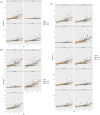Sex disparity of cerebral white matter hyperintensity in the hypertensive elderly: The Shanghai Changfeng study
- PMID: 36583389
- PMCID: PMC9980881
- DOI: 10.1002/hbm.26196
Sex disparity of cerebral white matter hyperintensity in the hypertensive elderly: The Shanghai Changfeng study
Abstract
White matter hyperintensity (WMH) is associated with vascular hemodynamic alterations and reflects white matter injury. To date, the sex difference of tract-specific WMH and the relationship between high blood pressure (BP) and tract-specific WMH remain unclear. We recruited 515 subjects from the Shanghai Changfeng study (range 53-89 years, mean age 67.33 years). Systolic and diastolic blood pressure (SBP and DBP) were collected and used to calculate pulse pressure (PP). Magnetic resonance T1 and T2 FLAIR images were acquired to measure WMH and calculate WMH index. The ANCOVA test was performed to test the difference between sexes, and the linear regression model was used to examine the associations between BP and WMH index. Men showed higher WMH index than women in all white matter tracts (p < .001, respectively) except for the bilateral superior longitudinal fasciculus (SLF) and its left temporal part (tSLF). High SBP and PP was associated with a lower WMH index on the left corticospinal tract (CST), SLF, tSLF and right cingulum in hippocampus (p ≤ .001, respectively) in women, while high DBP was associated with a higher WMH index on the bilateral CST (left p < .001; right p = .001), left inferior longitudinal fasciculus (p < .001) and inferior fronto-occipital fasciculus (p = .002) in men. Men tend to have more WMH compared to women. A high SBP/PP relates to a lower WMH burden in women. This suggests that women could benefit from higher blood pressure in older age.
Keywords: MRI; high blood pressure; sex difference; tract-specific white matter hyperintensity.
© 2022 The Authors. Human Brain Mapping published by Wiley Periodicals LLC.
Conflict of interest statement
The authors declare no conflict of interest.
Figures



References
-
- Barry, D. I. (1985). Cerebral blood flow in hypertension. Journal of Cardiovascular Pharmacology, 7, S94–S98. - PubMed
-
- Blair, G. W. , Thrippleton, M. J. , Shi, Y. , Hamilton, I. , Stringer, M. , Chappell, F. , Dickie, D. A., Andrews, P., Marshall, I., Doubal, F. N., & Wardlaw, J. M. (2020). Intracranial hemodynamic relationships in patients with cerebral small vessel disease. Neurology, 94(21), e2258–e2269. 10.1212/wnl.0000000000009483 - DOI - PMC - PubMed
Publication types
MeSH terms
LinkOut - more resources
Full Text Sources
Medical
Miscellaneous

